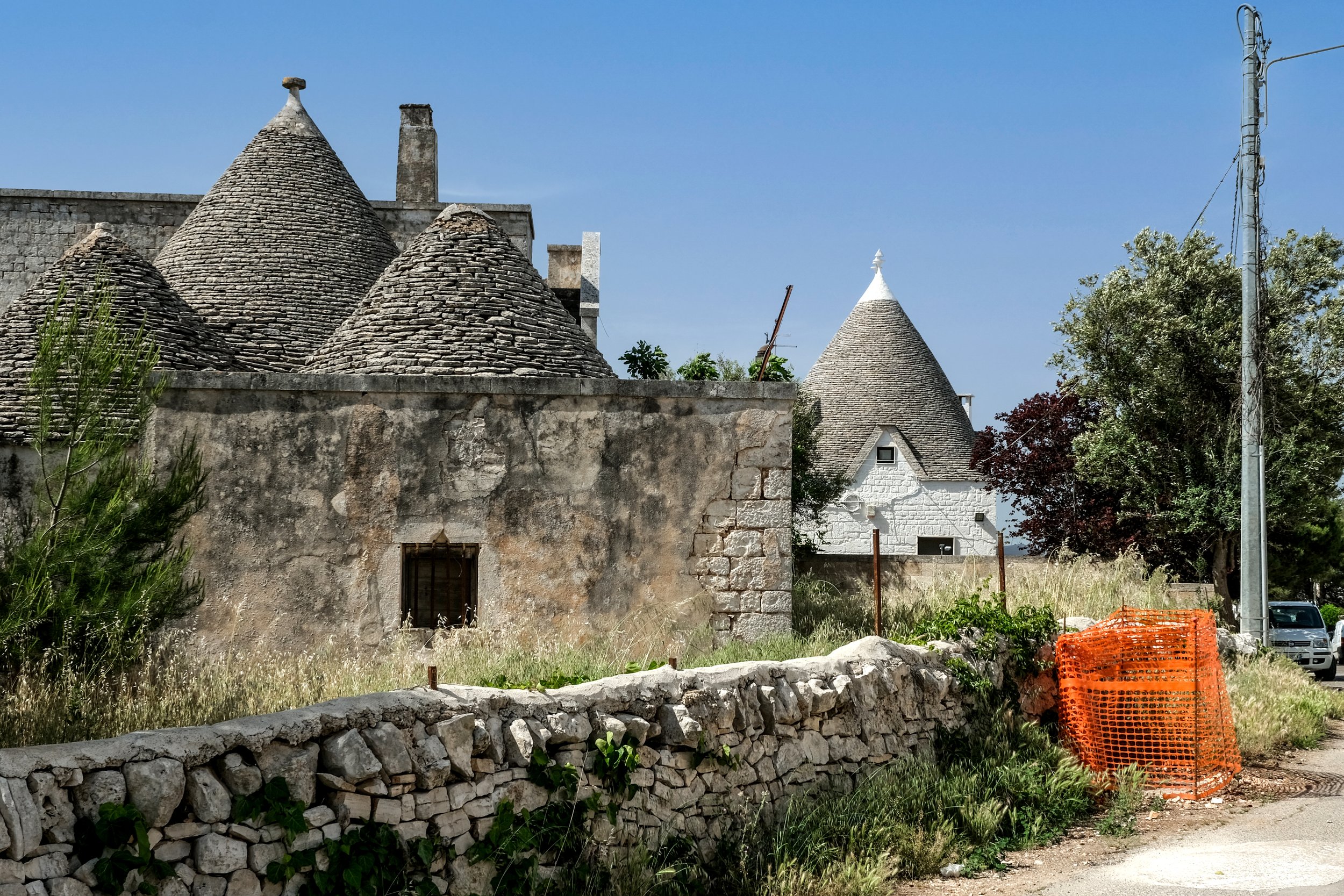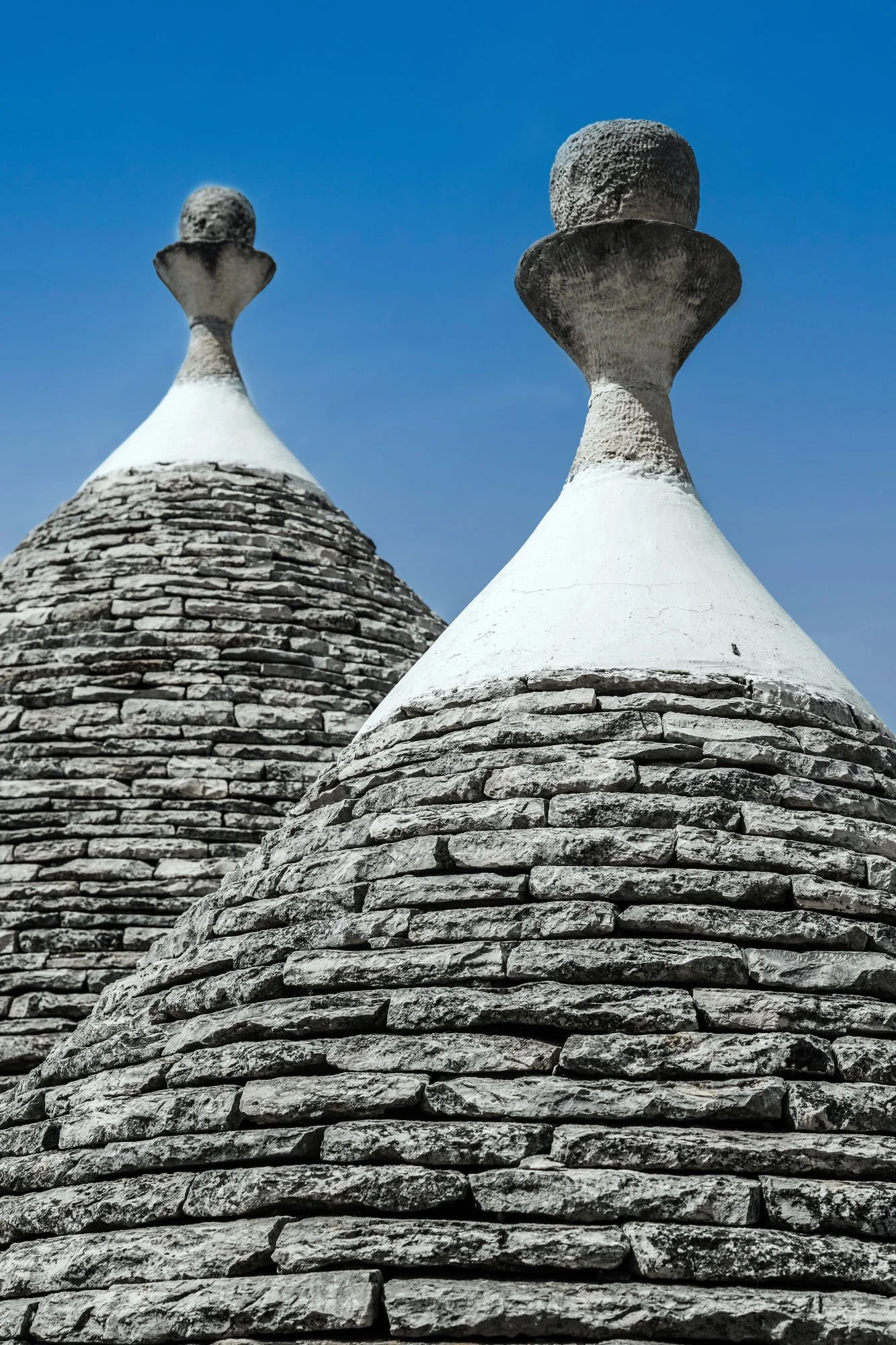Alberobello - A Perfect Photo Op
For anyone who has ever googled pictures of southern Itlay, the mages of Trulli houses are unavoidable. These characteristic conical-roofed structures are indigenous to only a particular corner of Puglia and arguably the region's biggest tourist draw. When we crossed the border from Basilicata to Puglia, we were excited to look out for any signs of Trulli houses. Sure enough, we saw our first Trullo a few minutes later. Words could not express just how excited I was. We felt the difference when crossing the border. The miles after miles of olive groves and Trulli structures may be why Puglia has become one of Italy's most popular tourist destinations recently.
Despite being the cultural symbols of Puglia, most Trulli structures are concentrated in a closely defined area called Itria Valley. The flat land is largely composed of karst limestone, which provides the basic materials for Trulli. They were primarily constructed as makeshift farm sheds in the field. Some were large enough to house farm workers or their small families. But in the town of Alberobello, the residents took the craft of Trullo-building a step further by constructing an entire settlement with trulli houses. There are a total of 1,600 trulli in Alberobello, and most are in a great state of preservation due to its designation as a UNESCO World Heritage Site.
While planning our itinerary for this recent trip, Brian and I deliberated for quite a while about whether to make Alberobello our home base. This being the most photogenic town in Puglia, it naturally is an attractive home base for exploration. Itria Valley is home to many of Puglia’s greatest hits: Locorotondo Ostuni, Martina Franca, and Ceglie Messapica. As an additional bonus, the seaside towns of Monopoli and Polignano a Mare are also only forty minutes away. The photographer within me longed to spend a few days here and capture the magic of this place at different times of the day. Ultimately, we opted for three nights in Monopoli instead to be close to the shore.
The Economic Case For Trulli
The true origin of Trulli is not absolutely certain, but most historians agree that the first cone-shaped structure, like Trulli, appeared in Asia Minor about three thousand years ago. From the 11th to 14th century, the coast of Puglia was the trading hand between the rivaling Kingdom of Naples and the Ottoman Turks. According to common legend, some Turkish mercenaries surrendered to the crown and offered services. In exchange, the king granted them narrow strips of land at the edge of grand estates. With limited resources, the Turks constructed these circular stone huts based on the knowledge of home-building from their homeland.
But of course, men have been building “primitive” stone structures ever since the Neolithic times. Trulli is no longer the ingenious design devised by the people of Puglia. Circularly vaulted stone structures, often associated with religious and funerary practices, can be found all over the Middle East and the Mediterranean Region. I could certainly see Trulli in the megalithic temples of Malta or the beehive tombs of Oman. These ancient building forms were a triumph of human ingenuity. They exemplify the structural longevity of the vernacular architecture.
What made Trulli especially interesting is the history of how they were propagated across Puglia. Most Trulli dates that survived today date from the 17th to 19th centuries. During that time, the local ruler was a dependent territory of the Aragonese Kingdom of Naples. The king announced that the construction of all new permanent structures must be approved by his administration and taxed appropriately. The local nobleman by the name of Andrea Matteo Acquaviva instructed his subject to construct stone houses without mortar so that they could be considered temporary structures. Because these stone structures could be theoretically disassembled and rebuilt elsewhere, they were a perfect tax evasion scheme.
Though it is technically possible to move and rebuild a Trulli for taxation purposes, there was only one recorded instance of such an occurrence. Ironically, these “temporary” structures outlast many of their permanent counterparts. Throughout the Itria Valley, Trulli structures are designed as accessory structures supporting working farms. Most were used for sheltering animals or storing farm equipment. For the most part, no three Trulli would congregate together. In contrast, Alberobello stands out as a town almost entirely comprised of Trulli.
After the feudal control of Alberobello ended in 1797, the locals earned the privilege of building their own permanent houses from King Ferdinand IV, and Alberobello was granted the status of a “royal city.” Even though the previous regulation of permanent building was abolished, the locals continued building their villages with Trulli dwellings. With the private building formally “legalized,” the Trulli became increasingly complex and elaborate. The humble stone huts incorporate many architectural and ornamental elements absent in the countryside.
After the end of World War II, Alberobello experienced a severe population outflow to larger industrial cities. While its Trulli dwellings were still prized as important cultural heritage for the region, many were in danger of abandonment. With that, the knowledge and craft of Trulli construction were also at risk. Like many other rural European villages, Alberobello’s fortune changed considerably when it was officially inscribed as a UNESCO World Heritage Site in 1996. With that designation, Alberobello enjoyed an influx of tourism and financial resources. If anything, the popularity of Trulli may be its own greatest enemy.
The Anatomy of Alberobello
The modern town of Alberobello is quite a sprawling village. But despite modern architecture in some places, most of the town still comprises Trulli houses. The town occupies the two sloping banks of a dry creek, making it particularly photogenic in topography. The southern bank, Rione Monti, is where most tourist activities are, home to many of the most photogenic Trulli. On the north side, Rione Aia Piccola is often overlooked by visitors. For anyone with more than an hour to spare, this section of the town is far more enjoyable with its tranquility as it retains much of its original residential ambiance.
One of the most popular stops for visitors is Belvedere Santa Lucia, which overlooks the gentle slopes of Alberobello. This is easily the most popular spot for social media influencers. One thing that stood out for me is how tiny Trulli houses are in physical dimensions. The interior of a Trullo is barely large enough for a modern living room. It is difficult to imagine that this was meant for a family of six back in the day. Unlike the Trulli out on the farm, the structures in Alberobello followed a rectangular plan to better fit into the urban environment. The transition between the rectangular walls and the conical roof is beautiful.
At Alberobello, each Trulli is also topped with a distinctive sandstone pinnacle (pinnacolo); the unique design of this ornamental top is considered the unique signature of each master craftsman. The subtle difference in their design adds to a certain level of mysticism. But for most visitors, the most enigmatic part of a Trullo is the symbols whitewashed on the roof. According to the local guide, these symbols could be uncategorized into three categories: Christian, pagan, and magic. As much as we like to attach great cultural significance to them, they were painted merely as good luck charms by the individual Trullo owner. I imagine such practice has been particularly popular since the arrival of tourism. Frankly, most of these insignias only appear where tourists are.
The conical-shaped roof is made out of flat limestone in two layers. The inner layer provides structural stability, and the outer layer is sloped outward to prevent water penetration. As an architect, I am naturally quite doubtful of such a claim. Back home, we spent so much time and energy waterproofing our buildings. It is just crazy to think that a mortarless stone building could perform so well. If it was as magical, you have to wonder why it is not more widespread. Today, just enough Trulli are around to keep a team of special masons busy. It costs as much as €18,000 to reroof one Trullo nowadays. I was lucky enough to walk past a master mason at work; it is evident that this craft is a labor of love. Given the interest in tourism, new Trulli houses are now getting built from the ground up, sometimes not following the traditional scale or proportion.
While most of the Trulli structures are quite modest in height, a few are truly extravagant. The most famous of them all is probably Trullo Sovrano. It is the largest Trullo house in the world and the only one with two stories. This former residence of a wealthy family is composed of twelve Trulli and reached the height of 46 feet at its pinnacle. The other noted landmark, the Parish Church of Saint Anthony of Padua, is perhaps even more impressive. Built only a hundred years ago, the church is technically too large to be built without mortar. According to legend, the parish priest requested the architect incorporate elements of Trullo into the design to entice parishioners to worship in his new church.
For anyone who enjoys a rooftop view of Trulli, many entrepreneurial shop owners offer visitors free access to their rooftop terrace. Of course, the visit would be followed up by either an aggressive sales pitch or a donation box. The advent of tourism is a double-edged sword for small towns like Alberobello. Within Rione Monti, every Trullo has been converted to tourist shops or guest houses. I personally found its comparison to Disneyland to be quite apt. As beautiful and unique as Alberobello is, this is one place that I struggled to fall in love with on this trip. Perhaps at some point, the government will convert part of the town into an open-air museum. But in the meantime, it is nevertheless a perfect photo stop on any Puglia itinerary.



















